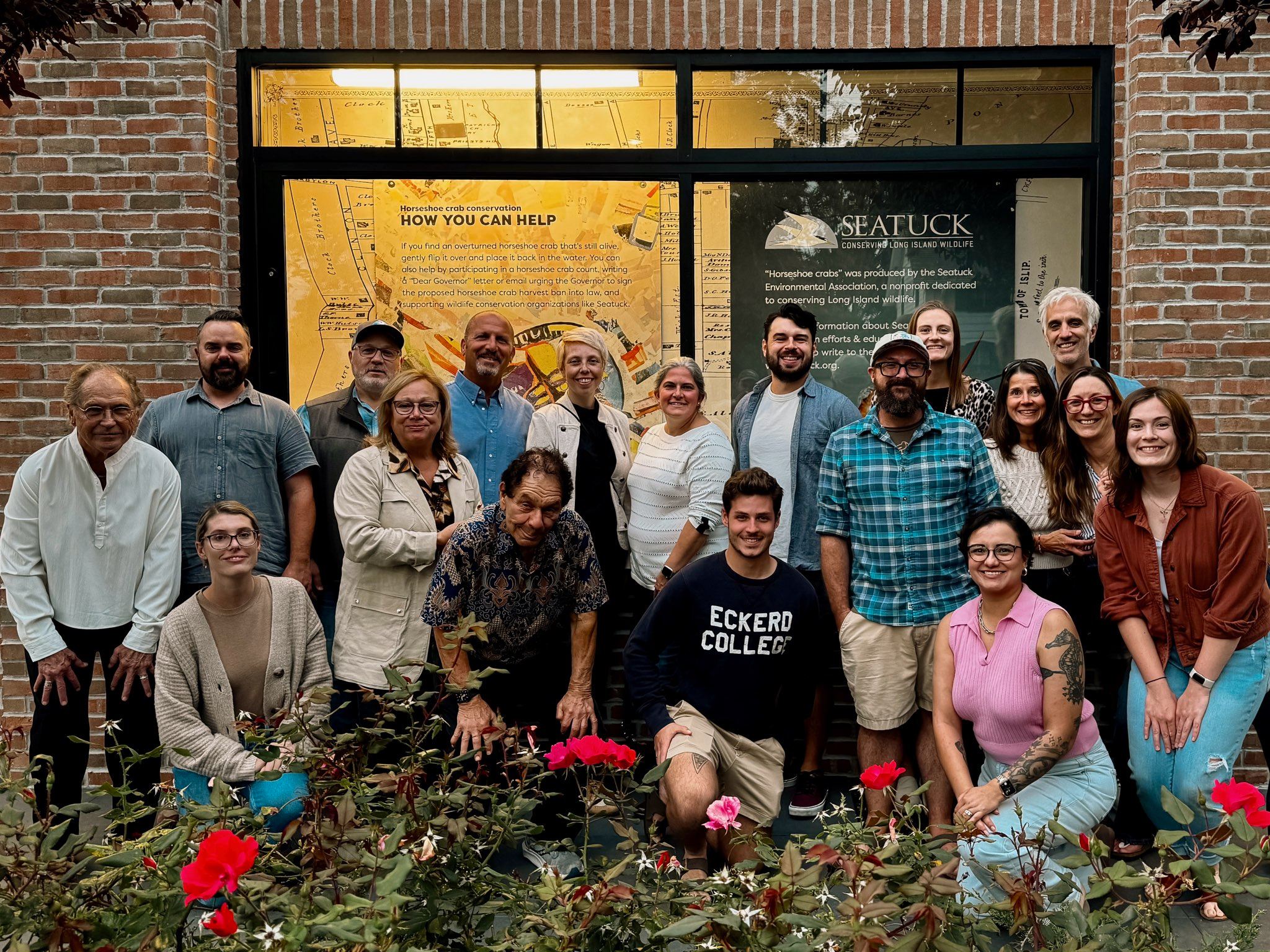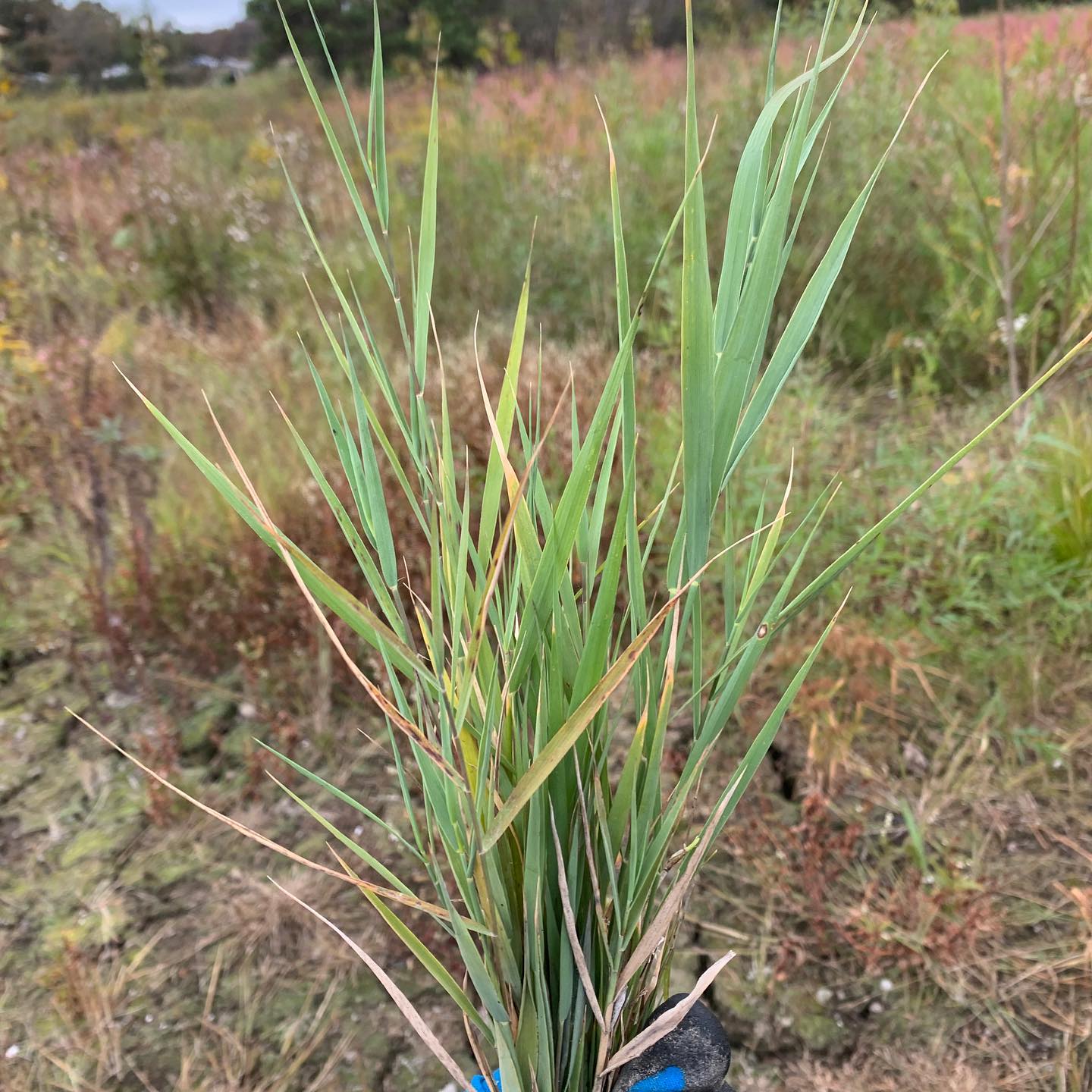On April 9 Newsday published a story by Jim Merritt about bats on Long Island. The article featured Seatucks’ Emily Hall and her work with bats.
Click here to read the story on the Newsday website. The text of the article is below.
Bat signals: Research, community projects aim to protect the creatures on LI
Emily Hall of Copiague didn’t officially join what she calls “the bat world” until last summer, when she connected her new bat detector to her cellphone and pointed it at the trees in her backyard.
“I was just exploring,” said Hall, 28, the conservation policy advocate at the Seatuck Environmental Association in Islip. She had learned at the nonprofit group’s annual fall Bats & Brews Benefit that bats might be emerging from the woods near her home at night to eat the bugs buzzing around a water source like her backyard pool.
Soon the detector, which translates ultrasonic bat feeding calls into audible sounds, started clicking, a sign bats were in the vicinity. Hall said that her sister, who accompanied her outside, “was shocked. She said, ‘Do you mean there are really bats here?’ “
But Hall, a Long Island native, had the opposite reaction. She was both happy and “amazed to see there were actually bats just flying around my backyard in the summertime.” When the detector identified the likely species — a big brown bat — Hall scanned the trees until she spotted the visitor flapping around.
This year, Hall is continuing her bat advocacy as an organizer of BatMap Long Island, a community service project now enlisting volunteer citizen scientists to report Long Island bat sightings. Anyone can use the app, Survey123, or visit seatuck.org/bats to report such data as where a bat was seen and whether it was emerging from trees or flying overhead.
The information will be analyzed, Hall said, “to understand where bats are on Long Island, where their foraging areas and roost sites are, and how to better conserve them,” and experts may follow up with a visit to the area where the bat was seen.
“I think people would be surprised how many bats there are on Long Island,” Hall said.
Rehabilitating bats’ image
By the time of International Bat Appreciation Day on April 17 (celebrated by the likes of Bat Conservation International, a U.S.-based conservation organization dedicated to ending bat extinctions), bats will already be emerging from winter hibernation across Long Island. That might not be a pleasant thought if you suffer from chiroptophobia — fear of bats — but it’s a call to action for those who believe the world’s only flying mammal has been unjustly portrayed as spreading disease or as a Halloween menace. In fact, bat populations are crucial to a balanced ecosystem yet are being decimated by their own epidemic of deadly white-nose syndrome.
The bat-centric projects also include: a three-year investigation into Suffolk County’s surprisingly disease-resistant bats; an annual bat survey that has found seven bat species in Islip; and a bat box building class on the East End.
Bats “get a bad rap all the time, but we want to promote all the great things they do,” said Maria Brown, who designed BatMap Long Island for Seatuck. Brown, a science research teacher at Sayville High School and a Stony Brook University lecturer, is the principal geospatial analyst for the International Union for Conservation of Nature’s Red List Bat Specialist Working Group, which focuses on protecting bat populations and their habitats globally.
Brown says that 1,432 species of bats have been identified around the world. As a geospatial analyst, she uses computer models to map the distribution and changes over time of global bat populations. She’s traveled around the world, sometimes accompanied by Sayville students or her daughter, Lexi, 27, of Cutchogue, a bat genomics researcher working on her doctorate at Stony Brook University.
This summer, as part of BatMap Long Island, Brown and her Stony Brook students will be monitoring bat activity closer to home, at the Greentree Foundation estate in Manhasset and Peconic Land Trust properties on the East End.
The BatMap Long Island project came about when Brown realized, that, ironically, “we have such a poor natural history documented for bats on Long Island, it would be nice to know where the bats are.” A pilot study conducted two years ago drew 85 bat-sighting reports from citizen scientists recruited at nature talks Brown gave at a Riverhead brewery.
According to Brown, 57, the two most common species found year-round on Long Island are big brown and eastern red bats, and in the summer months, hoary and silver-haired bats are also common. Also present but in much lower numbers: tri-colored, eastern small footed, northern long-eared and little brown bats.
Spreading knowledge
Those bats are all on the radar as BatMap Long Island takes off again this spring. In late March about 100 people attended “Bat Monitoring,” a Zoom webinar held by the Long Island Bat Working Group, a recently formed 15-member organization of scientists, conservationists and other chiropterologists. The purpose of the webinar was to introduce Long Islanders to the region’s bat species and how and where they might be found.
Experts offered tips on when to look for bats (dusk and dawn) and where encounters are most likely, such as above puddles along forest trails; they described how bats could be distinguished in flight from a birds by their jerky, fluttery motions. (Because bats can transmit rabies to humans, however, bats should never be handled by untrained and unvaccinated people or be kept as pets, according to the federal Centers for Disease Control and Prevention.)
Samantha Hoff, a University at Albany doctoral student who studies Suffolk County bats, told the fledgling BatMap volunteers to be on the lookout for hibernating species, such as tri-colored and little brown bats, and migratory hoary, red and silver-haired bats.
“Red bats are taking over Suffolk,” Hoff said, referring to their increasing numbers.
Last summer about 80 Long Islanders, including scientists and bat world newcomers, posted details of their bat encounters on the app.
Identifying Long Island bats
The swampy areas at Seatuck’s Islip property have been fertile bat monitoring ground for ecologist Thomas Gordon, an assistant professor of biology at Suffolk County Community College’s Ammerman Campus in Selden.
Gordon recently climbed up a ladder to hang another bat detector in a tree on the property to record echolocation calls, which he’s used there to identify all the species of bats found on Long Island. Gordon has also placed bat detectors — and recorded bat calls — at Bethpage State Park in Farmingdale and in other western Suffolk state parks and green spaces.
Gordon, who is in his 50s, says he’s liked bats since he was a child watching the “Batman” television series. Bats “are just the coolest animals out there,” he said. “They fly, they can see in the dark — and they are not blind; they have very good vision.”
Gordon said that bats also “provide crucial ecosystem services” and save billions of dollars in pesticides by feeding on insects that damage crops.
“Every night bats eat their body weight in mosquitoes and mosquito-sized insects,” Gordon explained, adding, “They are among the most important seed disbursers and pollinators for tropical forests around the world.” For instance, bats pollinate the agave plant, which is fermented to make tequila. “If you get rid of those bats, you get rid of tequila.”
Despite their importance to agriculture and pest control, bats are still little understood by the public, experts say.
“One of the things that people don’t appreciate is that they [bats] live a long time, for 30 or 40 years, maybe even longer, and certainly longer than a lot of animals,” said Carl Herzog, a New York State Department of Environmental Conservation wildlife biologist who has been studying bats since 2004.
Herzog said that bats “have a very high-energy lifestyle, too, which is another thing you usually don’t find with long-lived animals.” Their tendency to burn through calories has allowed an exotic disease known as white-nose syndrome to decimate bat populations in New York, he said.
Help from mild climate
The fungus, which first appeared in 2007, irritates the bats’ skin so much that they fly out of their hibernation site early and either die of starvation because there’s nothing to eat or are eaten by predators, Herzog said.
This spring, Herzog, Hoff and Casey Pendergast, another Albany graduate bat researcher, are concluding a three-year study to determine the geographical range in Suffolk County of northern long-eared bats, which have proved to be resistant to white-nose syndrome. The study was initiated after what Herzog called a “great surprise” — a 2012 Brookhaven National Laboratory survey that found a relatively large number of northern-long eared bats in Suffolk.
The year before, a bat had been found outside one of the laboratory buildings. “It turned out to be a northern long-eared bat and it had white-nose syndrome, the first documentation of white-nose on Long Island,” said Timothy M. Green, the laboratory’s environmental compliance section manager.
Using nets to catch live bats and acoustical monitoring equipment to find and identify them by their calls, Hoff and Pendergast located northern long-eared bats living in unusual spots — such as crawl spaces in homes. Montauk turned out to be a “hot spot” of northern-long-eared activity, Hoff said.
Hoff and Pendergast’s “work suggests that this species has been able to persist on Long Island and similar areas of coastal Massachusetts by employing a fascinating and previously unknown survival strategy that takes advantage of the relatively mild local winter climate,” Herzog said. He added that “the DEC continues to survey these bats while we develop a management approach aimed at ensuring their continued presence.”
Meanwhile, Hall recently continued her pro-bat crusade by offering a presentation on bats at the Avenues Studio Hamptons, an international private school with a campus in East Hampton. During the presentation, Hall told mentor Jesse Spooner’s Grade 6 class that “it’s really neat to think that bats can be the size of your thumb or have a 3-foot wingspan.”
Hall also told the children about bat boxes, which can be installed in backyards for bats to roost in during the summer, providing homes for bats pushed out of their natural habitats by human development.
After the presentation, the students watched Hall’s Youtube video about building a bat box and then made their own boxes in the classroom using cedar fence posts and plywood gutter guards for the bats to roost on, Spooner said.
“We had many requests for family and friends to build bat houses for their properties,” Spooner said. “It’s really cool that my students were able to change the perception many of the parents had about bats in general and about how beneficial they are.”
Added Spooner: “We hope this momentum can continue to spread throughout the Hamptons community and more people will recognize the importance of this local species.”
Going to bat for bats
Want to become part of Long Island’s bat world and help save a threatened species? You can:
Report bat sightings using the BatMap Long Island survey at seatuck.org.
Learn how to build a bat house for the flying mammals to use during the summer at the New York State Department of Conservation website dec.ny.gov/docs/administration_pdf/batbox.pdf.
Find 10 ways to become more bat-friendly at fws.gov/midwest/endangered/battips.html.




